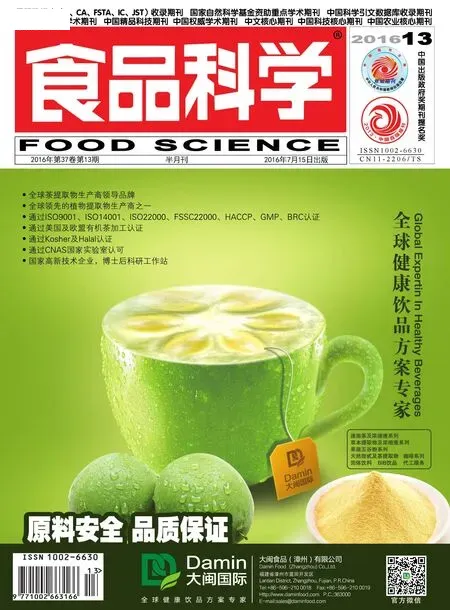土壤施用硒肥对猕猴桃含硒量、镉铅积累及品质的影响
龙友华,张 承,吴小毛,*,李 明,姚 雪,邵 双(.贵州大学农学院,贵州 贵阳 550025;2.贵州大学 作物保护研究所,贵州 贵阳 550025)
土壤施用硒肥对猕猴桃含硒量、镉铅积累及品质的影响
龙友华1,2,张 承1,吴小毛1,2,*,李 明1,2,姚 雪1,邵 双1
(1.贵州大学农学院,贵州 贵阳 550025;2.贵州大学 作物保护研究所,贵州 贵阳 550025)
摘 要:以“贵长”猕猴桃为实验材料,研究外源硒对猕猴桃硒含量、镉和铅积累和内在品质的影响。将亚硒酸钠按0.00、1.25、2.50、5.00、10.00、20.00 mg/kg的剂量分别添加于水、有机肥中进行土壤穴施。结果表明:硒肥添加于水、有机肥中均能增加猕猴桃硒含量,降低镉和铅的积累,改善猕猴桃果实品质;但硒肥添加于有机肥中效果更为显著。随着硒肥中硒含量的增加,猕猴桃果实中硒含量逐渐增加,镉和铅含量急剧降低。在1.25~10.00 mg/kg的亚硒酸钠施用含量范围内,猕猴桃果实VC、可溶性总糖、可溶性固形物、干物质和可滴定酸的含量得到显著改善。生产上推荐使用5.00~10.00 mg/kg的亚硒酸钠添加于有机肥中进行土壤穴施。
关键词:猕猴桃;有机肥;富硒;镉铅积累;品质
引文格式:
LONG Youhua, ZHANG Cheng, WU Xiaomao, et al.Application of Se-fertilizer affects selenium content, cadmium and lead accumulation and fruit quality in kiwifruits[J].食品科学, 2016, 37(13): 82-88.DOI:10.7506/spkx1002-6630-201613015. http://www.spkx.net.cn
LONG Youhua, ZHANG Cheng, WU Xiaomao, et al.Application of Se-fertilizer affects selenium content, cadmium and lead accumulation and fruit quality in kiwifruits[J].Food Science, 2016, 37(13): 82-88.(in English with Chinese abstract)
Selenium (Se) is a trace element of fundamental importance to many organisms, including humans and other animals, and a beneficial nutrient for many plants.Se deficiency may damage the development and function of the immune system, which tends to enhance susceptibility viral infections and heart problems, such as heart disease,liver cancer, hypothyroidism[1-2].As a crucial component of glutathione peroxidase (GSH-Px) and thioredoxin educates,Se exerts positive impact on the growth improvement of plants, increase of antioxidative capacity, reduction of reactive oxygen species (ROS) and lipid peroxidation, delay of senescence, alleviate of heavy metals toxicity and enhance of photosynthesis[3].
Cadmium (Cd) and lead (Pb) are the most dangerous and widespread environmental contaminants[4-5], especially in agricultural soils, have a direct risk to both human and ecological receptors due to their relatively high toxicity and plant readily uptake[6].Numerous studies have shown that Cd and Pb can do obviously harm to nervous system,bone marrow hematopoietic function, digestive system,reproductive system and other human body function,and induce the wrong expression of gene and arouse the cancer[7-8].In plants, Cd and Pb can cause oxidative stress,inhibit photosynthesis and decrease the chlorophyll contents,destroy the cell membrane integrity, and inhibit the uptake of certain essential elements such as Zn, Fe, Cu and Mg[9].So it is important to develop reliable approaches to prevent Cd and Pb accumulation in agricultural products.It is interesting to note that Se is one of the potential antagonists to Cd and Pb, recent publications indicate that Se addition may also alter the total content of Cd and Pb by reducing their uptake by plants such as Pteris vittata L., Sinapis alba L., Brassica rapa and Lactuca sativa L.[9-11].Similar results were observed on broccoli, strawberry, sweet persimmon, watermelon, and potato[12-14].Why Se can cause the antagonism of Cd and Pb in plants? There are two possible mechanisms.Firstly, it may affect by regulating the uptake and redistribution of essential elements in the antioxidative systems or in maintaining the ion balance and structural integrity of the cell.Secondly,it may interfere with electron transport by affecting the assembly of the photosynthesis complexes[15].
Organic fertilizer, a green fertilizer, not only can provide more comprehensive nutrition for crops, but increase and update organic matter of soil, promote the breeding of microorganism, improve soil physical and chemical properties, compared with chemical fertilizer.Studies have shown that organic fertilizer can improve yield and quality of crops, and increase the stability of heavy metals in the soil and reduce the enrichment of heavy metal in agricultural products[16-18].On one hand, organic fertilizer has abundant functional groups and large specific surface area that can increase precipitation of heavy metals in the form of sulfide.On the other hand, heavy metals can generate stable clathrate with organic ligands in organic fertilizer, so as to reduce the bioavailability of heavy metal ions[19].
As an emerging fruit of world recognized[20], kiwifruit has a high nutritional value that derives from the fruit containing a variety of amino acids and vitamins, and is rich in minerals, which plays a key role in maintaining human health.The harvested area and yield of kiwifruit in the world continuously increased in the 21stCentury.In China, kiwifruit industry had rapid development, and cultivation area and yield were rank first in the world.However, the cultivation technique deficiency and agricultural contamination may cause the kiwifruit quality and safety problem.In view of the importance of kiwifruit and Se for human nutrition and health, the aim of this study was to investigate the potential role of exogenous Se by different application forms on the selenium-enriched,accumulation of Cd and Pb, and fruit internal quality in kiwifruit.The present study can provide a basis for developing strategies to lower risks associated with Cd and Pb toxicity and cultivating selenium-enriched plant products.
1 Materials and Methods
1.1 Study site and plant material
Experiments were carried out on kiwifruit cultivar ‘Guichang', planted in 2003, in the kiwifruit garden in 2013 at Xiuwen county, Guiyang, China (26˚48′36.1″N,106˚28′25.3″E; 1 354 m).The kiwifruit cultivar ‘Guichang' has long storage period, good quality and high yield performance, and planting area in Southwest China reached 20 000 hm2.The “T” type frame of kiwifruit, with spacing of 3.0 m × 3.0 m, the proportion of male: female vines was 1:8.Mean temperature in the kiwifruit garden was about 15-16 ℃, rainfall was 1 293 mm, and soil was loam.The soil (0-60 cm in deep) had total organic matter content of 29.54 g/kg, total nitrogen of 1.42 g/kg, alkali-hydrolyzable nitrogen of 98.45 mg/kg, available phosphorus of 4.40 mg/kg,available potassium of 0.61 mg/kg, available iron of 49.31 mg/kg, available zinc of 1.89 mg/kg, available manganese of 19.17 mg/kg , total zinc of 50.66 mg/kg, totalchromium of 0.56 mg/kg, total Pb of 29.30 mg/kg, total Se of 77.69 μg/kg.The pH value of the planting soil was 5.82.
1.2 Chemicals and Instruments
Sodium selenite was purchased from Xiya Reagent (AR,Chengdu, China); Standard solutions of Se, Cd and Pb were purchased from SIMT (GBW(E), Shanghai, China); Organic fertilizer was purchased from Dibao Biological Technology (Guiyang, China), and its organic matter content is more than 45%, (N+P2O5+K2O) content is more than 5%; Microwave dissolver was produced by SINEO (Shanghai, China);AF-7500 double-channel hydride atomic fluorescence photometer was obtained from East & West Analytical Instruments; TAS-986 atomic absorption spectrophotometer was obtained from Purkinje General Instrument (Beijing, China).
1.3 Experimental design
Sodium selenite was spiked with the irrigation water and organic fertilizer at a concentration of 0.00, 1.25, 2.50,5.00, 10.00, 20.00 mg/kg.And a total of twelve treatments,forty-eight plots were arranged in a randomized block design with four replicates.Each plot consisted of six trees, only the interior four trees were used for measurements.On 29thApril and 2edAugust, six sodium selenite treatments (0.00, 1.25,2.50, 5.00, 10.00, 20.00 mg/kg as sodium selenite in water solution and organic fertilizer) were applied two times by soil deep-ditch fertilization.Soil deep-ditch was excavated by digging around and close to the plant roots which the deep and wide of circular ditch (30-50 cm).
1.4 Plant sampling and analysis
Kiwifruit samples of 100 fruits were collected randomly from each plot on October 1st, 2013 and stored at -20 ℃until analysis.VC, total soluble solids, total soluble sugar,dry matter percentage, titratable acidity, as well as Se, Cd and Pb contents were evaluated.The VC content was analyzed by 2,6-dichlorophenolindophenol titration methods, the total soluble solid was measured with a digital refractometer.Total soluble sugar was analyzed by anthrone colorimetric method, and dry matter percentage (%) was evaluated by the difference between weighting the samples before and after 48 h in a stove at 100 ℃, while titratable acidity was analyzed by acid-base titration.
Total Se content in fruit samples was determined using atomic fluorescence spectrometry (AFS).Before the measurement, samples of 1.000 g were digested with 6 mL of concentrated HNO3and 2 mL of 30% H2O2in a microwave digestion system.Cd and Pb contents were analyzed by the atomic absorption spectrometry (AAS) method with digestion of 1.000 g fruit samples with a mixture of 6 mL HNO3and 4 mL HClO4.After digestion, the residues were diluted to 25 mL with ultrapure water.
1.5 Statistical analyses
2 Results and Analysis
2.1 Effects of Se-fertilizer on Se content in kiwifruit
The soil deep-ditch fertilization of sodium selenite in the irrigation water and organic fertilizer were highly effective for increasing total Se content in kiwifruit, which increased gradually with the increasing input of sodium selenite (Fig.1).While sodium selenite was added in the irrigation water, Se content in kiwifruit for treatments of 1.25, 2.50 mg/kg sodium selenite was not significantly different, compared to 0.00 mg/kg sodium selenite (Fig.1).The total Se content in samples from sodium selenite in the irrigation water and organic fertilizer was 0.017 6-0.021 6 mg/kg and 0.017 9-0.067 4 mg/kg FW (in fresh weight), respectively.The application of 2.50,5.00, 10.00 and 20.00 mg/kg levels of sodium selenite in organic fertilizer led to the greatest increase of Se content in kiwifruit with content values of 0.026 7, 0.037 9, 0.045 8 and 0.067 4 mg/kg FW, respectively.It was 1.46, 2.02,2.26 and 3.11 times higher than the corresponding levels of sodium selenite in irrigation water, respectively (Fig.1).This indicates the application of sodium selenite combined with organic fertilizer can better promote the intake of selenium by kiwifruit.The possible reasons that application of organic fertilizer could quickly increase soil organic matter content and microbial quantity, enhance the activity of soil enzyme and root system[21-22], and then promote plant intake mineral elements from soil.
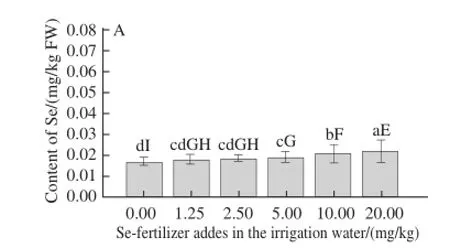

Human Se intake is determined largely by food Se composition.Many areas in the world contain low Se levels,such as in Europe, Australia, New Zealand, India, Thailand and China[23].It is estimated that approximately more than 1 billion people worldwide are Se deficient, considered as the fourth most serious deficiency of minerals in human body[24].According to the Food and Agriculture Organization of the United Nations (FAO), the recommended minimum daily Se intake for adults is 70 µg/d, with a maximum tolerable level of 400 µg/d.While the World Health Organization recommends 40 µg/d,supplementation at 50-200 µg/d is nontoxic and improves immune responses, reduces bacterial and viral infections,and the onset of many heart diseases[23].Based on the present results, the Se-enriched kiwifruit could contribute to the dietary Se intake and kiwifruit commodity value.
2.2 Effects of Se-fertilizer on Cd content in kiwifruit
Cd content in kiwifruit was markedly affected by the different sodium selenite regimes (Fig.2).Sodium selenite at all applied levels induced a significant decrease of internal Cd concentrations in kiwifruit, especially the treatments that sodium selenite was added in the organic fertilizer.The reduction in Cd content in kiwifruit at 1.25-20.00 mg/kg levels of sodium selenite in both irrigation water and organic fertilizer with values of 4.59%-11.46% and 9.72%-29.33%, respectively, as compared to 0.00 mg/kg sodium selenite of irrigation water (Fig.2).Whereas 0.00 mg/kg and 10.00 mg/kg sodium selenite in organic fertilizer also reduced Cd content by 5.58% and 25.81%, respectively (Fig.2).
Strategies for reducing Cd contamination and related health risks are urgently desired in recent years.The alleviated Cd toxicity by Se application related to reduce Cd intake has been reported[25-26].Furthermore, organic matter also has become a growing concern in decrease the mobility of heavy metals by sorption and precipitation[27-29], hindering heavy metals into biological cycles.The results by Karlsson[30]indicate that Cd could form stable clathrate with the carboxyl (RCOOH) and sulfhydryl (RSH) groups in organic matter.In this study, sodium selenite applied with combination of organic fertilizer had better effect on significant reducing Cd content in kiwifruit than single application of sodium selenite or organic fertilizer (Fig.2).The results presented here show that the mixed fertilization of sodium selenite and organic fertilizer should have obviously synergistic effects to relieve Cd contamination in kiwifruit.
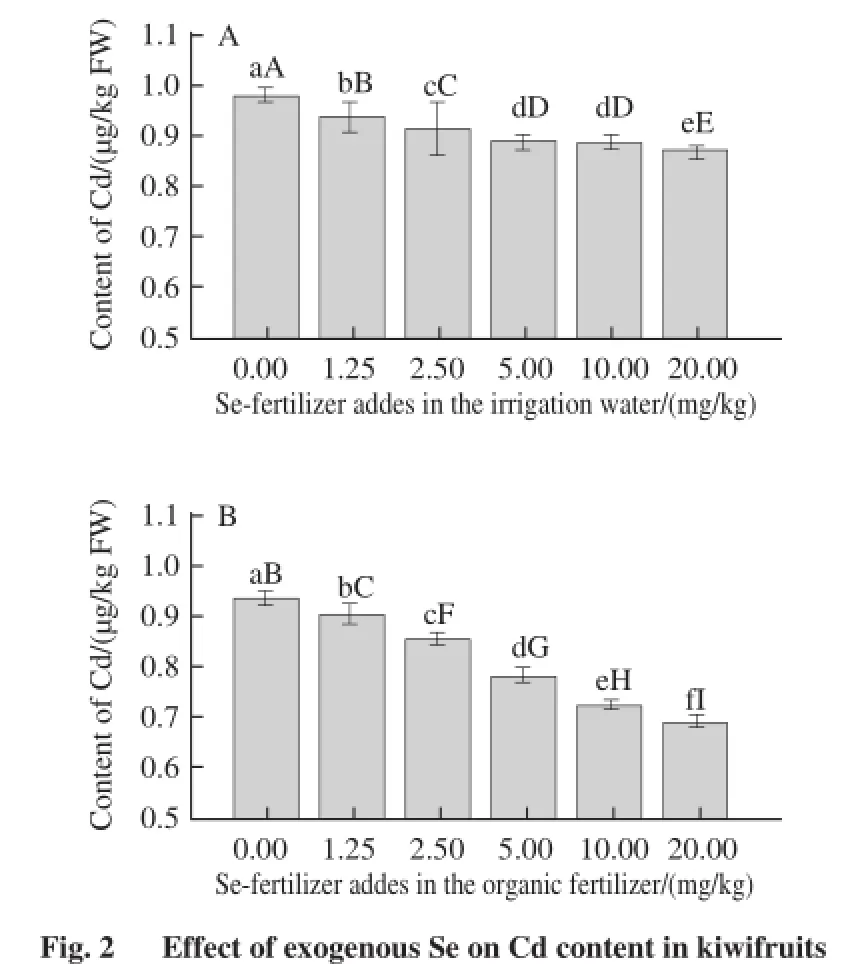
2.3 Effects of Se-fertilizer on Pb content in kiwifruit
The data presented in Fig.3 shows that 0.00 mg/kg sodium selenite in irrigation water resulted in a high Pb accumulation within fruits of kiwifruit, reaching 2.76 µg/kg FW.Pb content in 0.00 mg/kg sodium selenite treatments was 1.07-1.28 and 1.11-1.69 times higher than that of 1.25-20.00 mg/kg levels of sodium selenite in irrigation water and organic fertilizer, respectively.As indicated, the different sodium selenite regimes significantly decreased the kiwifruit plant intake of Pb from soil, which decreased with the increase of application doses, and a similar phenomenon was observed for Cd accumulation.The effect of the sodium selenite added in organic fertilizer was greater than in irrigation water.As compared with 0.00 mg/kg sodium selenite in irrigation water, 10.00 mg/kg and 20.00 mg/kg sodium selenite in organic fertilizer could reduce 33.01% and 40.66% Pb content in kiwifruit, respectively.The application of 20.00 mg/kg sodium selenite in irrigation water also could reduce 21.71% Pb content (Fig.3).
Se can reduce Pb content in plants and antagonize Pb toxicity by preventing damage from oxygen free radicals or by forming Se-Pb protein complexes, such as reducing superoxide anion (O·) and increasing the activity and content of GSH-Px, superoxide dismutase (SOD) or thyroid stimulating hormone (TSH) etc.[31-33].Additionally, related studies indicate that the increases of soil pH value and organic matter caused the reduction of Pb in plants[27-28,34],while organic fertilizer could precisely increase soil organic matter content and improve soil acidity.In the present study,single fertilization of sodium selenite or organic fertilizer,and their mixed fertilization were able to reduce the content of Pb in kiwifruit (Fig.3).Compared to alleviating Cd contamination, the synergistic effects for Pb contamination was more noticeably of sodium selenite and organic fertilizer.
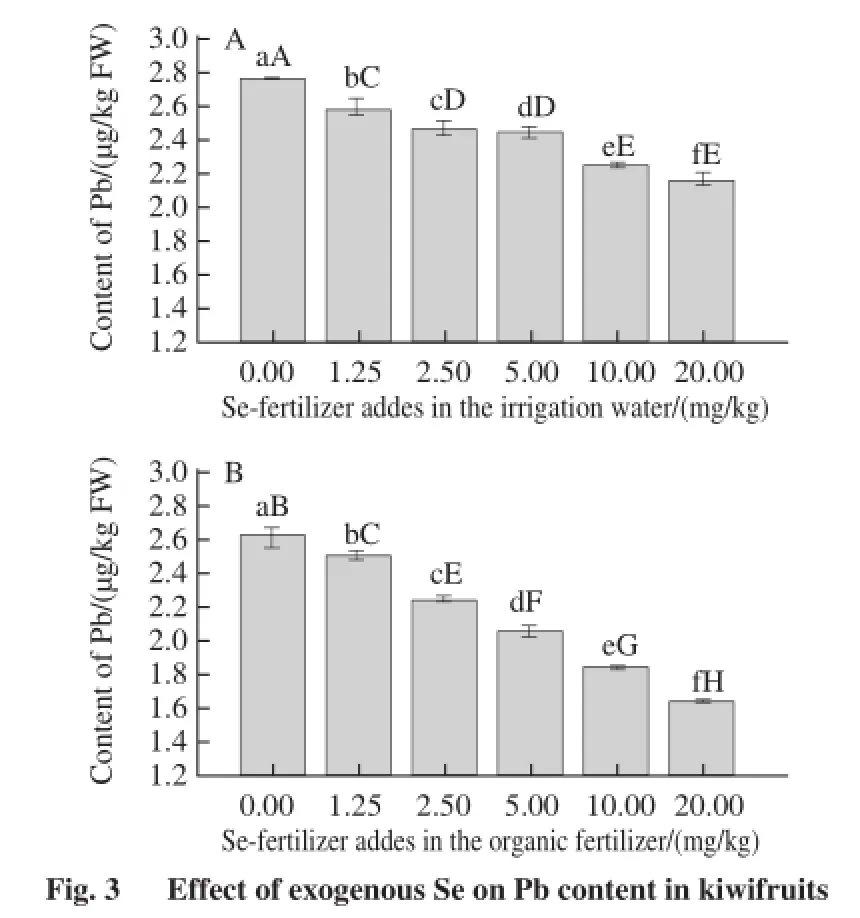
2.4 Effects of Se-fertilizer on fruit quality in kiwifruit
The nutritional parameters in fruits of kiwifruit are shown in Table 1.The appropriate doses of sodium selenite treatments influenced VC, soluble total sugar, soluble solid,titratable acid, dry matter content and sugar-acid ratio of kiwifruit, and improved fruit internal quality of kiwifruit.With the increasing levels of sodium selenite to 10.00 mg/kg,all quality parameters in fruits gradually increased (Table 1).However, these quality parameter values did not increase when the dose of sodium selenite was more than 10.00 mg/kg.The results show that after soil application with sodium selenite (from 1.25 to 10.00 mg/kg ) in irrigation water and organic fertilizer, VC, soluble total sugar, soluble solid, and dry matter content of kiwifruit was increased by 1.51%-19.93% and 9.36%-32.53%, 0.83%-15.84% and 4.82%-26.35%, 0.82%-8.05% and 2.53%-11.67%, and 0.83%-6.38% and 2.78%-13.92%, respectively, as compared to 0.00 mg/kg sodium selenite in irrigation water.While titratable acidity of kiwifruit was reduced by 1.27%-9.43% and 5.03%-12.58% (Table 1).It indicates that soil application with sodium selenite in organic fertilizer had more effective improvement to fruit internal quality of kiwifruit.And the mixed fertilization of sodium selenite and organic fertilizer should have obviously synergistic effects.
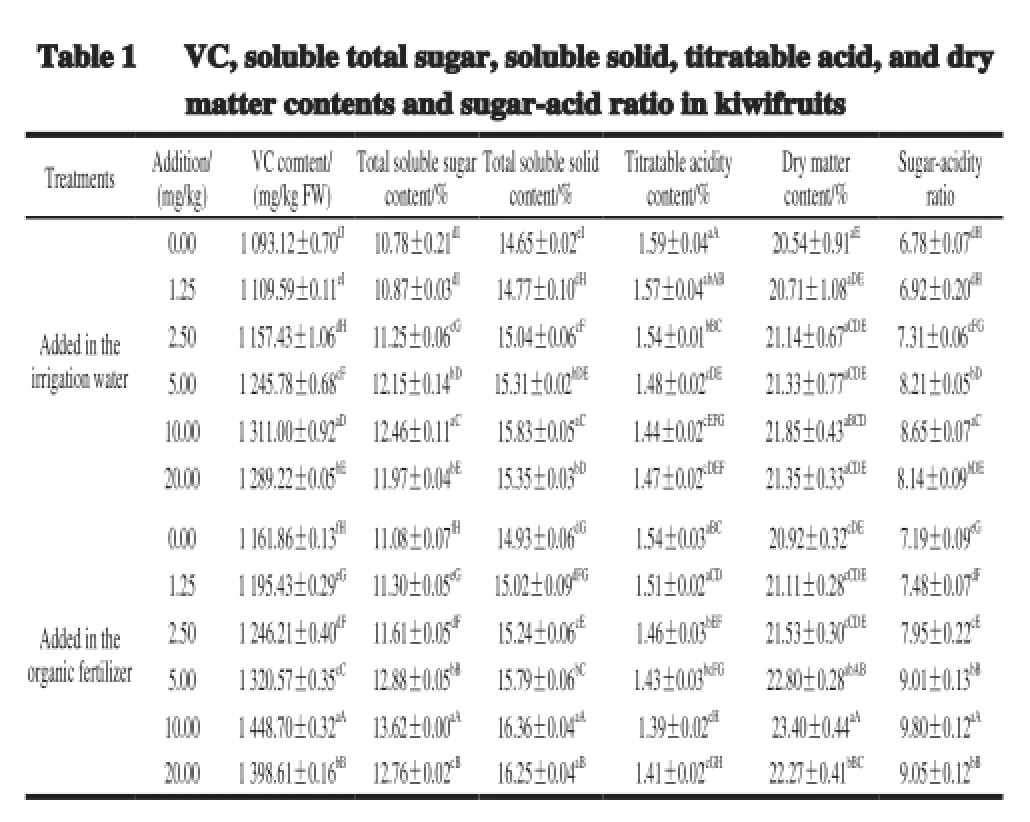
Table 1 VC, soluble total sugar, soluble solid, titratableacid, anddrymatter contents and sugar-acid ratio in kiwifruits Treatments Addition/ (mg/kg)VC comtent/ (mg/kg FW)Total soluble sugar content/% Total soluble solid content/% Titratable acidity content/% Dry matter content/% Sugar-acidity ratio Added in the irrigation water 0.00 1 093.12±0.70fJ10.78±0.21dI14.65±0.02eI1.59±0.04aA20.54±0.91aE6.78±0.07dH1.25 1 109.59±0.11eI10.87±0.03dI14.77±0.10dH1.57±0.04abAB20.71±1.08aDE6.92±0.20dH2.50 1 157.43±1.06dH11.25±0.06cG15.04±0.06cF1.54±0.01bBC21.14±0.67aCDE7.31±0.06cFG5.00 1 245.78±0.68cF12.15±0.14bD15.31±0.02bDE1.48±0.02cDE21.33±0.77aCDE8.21±0.05bD10.00 1 311.00±0.92aD12.46±0.11aC15.83±0.05aC1.44±0.02cEFG21.85±0.43aBCD8.65±0.07aC20.00 1 289.22±0.05bE11.97±0.04bE15.35±0.03bD1.47±0.02cDEF21.35±0.33aCDE8.14±0.09bDEAdded in the organic fertilizer 0.00 1 161.86±0.13fH11.08±0.07fH14.93±0.06dG1.54±0.03aBC20.92±0.32cDE7.19±0.09eG1.25 1 195.43±0.29eG11.30±0.05eG15.02±0.09dFG1.51±0.02aCD21.11±0.28cCDE7.48±0.07dF2.50 1 246.21±0.40dF11.61±0.05dF15.24±0.06cE1.46±0.03bEF21.53±0.30cCDE7.95±0.22cE5.00 1 320.57±0.35cC12.88±0.05bB15.79±0.06bC1.43±0.03bcFG22.80±0.28abAB9.01±0.13bB10.00 1 448.70±0.32aA13.62±0.00aA16.36±0.04aA1.39±0.02cH23.40±0.44aA9.80±0.12aA20.00 1 398.61±0.16bB12.76±0.02cB16.25±0.04aB1.41±0.02cGH22.27±0.41bBC9.05±0.12bB
Se is primarily assimilated from the soil by plants as selenate (SeO) or selenite (SeO).After intake, it has been proposed to be transported into the chloroplasts, inadvertently via sulfate transporters, metabolized it through the sulfate assimilation pathway, incorporated into multiple organic selenium compounds and dedicated vital potential role to growth of plants[3,35].Se has two distinct effects on plants: low concentration of selenium can enhance photosynthesis and promote plant growth, lower lipid peroxidation and alleviate influences of adversity[36-37].And other a high dose of Se may lead to plants poisoning, decrease quality and yield[3].Studies have shown that organic fertilizer has a good role in promoting on yield formation and quality improvement of kiwifruit, also can extend kiwifruit storage period[38].The results from this study show that organic fertilizer and appropriate doses of sodium selenite could enhance kiwifruit quality, and the effect of their mixed fertilization was better (Table 1).However, more than 10.00 mg/kg sodium selenite may cause kiwifruit poisoning due to a high concentration of Se in kiwifruit and the nutritional parameters did not continue to increase.Therefore, 5.00-10.00 mg/kg sodium selenite in organic fertilizer was recommended for cultivation of kiwifruit.Sodium selenite was applied with combinationof organic fertilizer could be applicable to the development of excellent Se-enriched kiwifruit and remediation of heavy metals (such as Cd and Pb) contamination.
3 Conclusions
The results from a field experiment show soil fertilization of appropriate dosage of Se in both irrigation water and organic fertilizer could reliably increase Se content, notably decrease the accumulation of Cd and Pb, and effectively improve quality of kiwifruit cultivar ‘Guichang'.Furthermore, application of sodium selenite combined with organic fertilizer was more effective than with irrigation water solution.Based on results of the current study, soil application of Se with combination of organic fertilizer might provide a promising strategy for cultivating selenium-enriched kiwifruit and further reducing kiwifruit heavy metals content to guarantee quality and safety of agriculture products.
References:
[1] COMBS G F.Food system-based approaches to improving micronutrient nutrition: the case for selenium[J].Biofactors, 2000,12(1/2/3/4): 39-43.DOI:10.1002/biof.5520120107.
[2] FORDYCE F M.Selenium deficiency and toxicity in the environment[M]// SELINUS O, ALLOWAY B J, CENTENO J A, et al.Essentials of medical geology.Revised edition.New York: Springer Dordrecht Heidelberg, 2012: 375-416.DOI:10.1007/978-94-007-4375-5.
[3] ELLIS D R, SALTA E.Plants, selenium and human health[J].Current Opinion in Plantbiology, 2003, 6(3): 273-279.DOI:10.1016/S1369-5266(03)00030-X.
[4] NEEDLEMAN H.Lead poisoning[J].Annual Review of Medicine,2004, 55: 209-222.DOI:10.1146/annurev.med.55.091902.103653.
[5] WU F B, ZHANG G P, DOMINY P, et al.Differences in yield components and kernel Cd accumulation in response to Cd toxicity in four barley genotypes[J].Chemosphere, 2007, 70(1): 83-92.DOI:10.1016/j.chemosphere.2007.06.051.
[6] CHEN F, WU F B, DONG J, et al.Cadmium translocation and accumulation in developing barley grains[J].Planta, 2007, 227(1): 223-232.DOI:10.1007/s00425-007-0610-3.
[7] HSU P C, GUO Y L.Antioxidant nutrients and lead toxicity[J].Toxicology, 2007, 180(1): 33-44.DOI:10.1016/S0300-483X(02)00380-3.
[8] QAISER S, SALEEMI A R, UMAR M.Biosorption of lead from aqueous solution by Ficus religiosa leaves: batch and column study[J].Journal of Hazardous Material, 2009, 166(2/3): 998-1005.DOI:10.1016/j.jhazmat.2008.12.003.
[9] HE P P, LÜ X Z, WANG G Y.Effects of Se and Zn supplementation on the antagonism against Pb and Cd in vegetables[J].Environment International, 2004, 30(2): 167-172.DOI:10.1016/S0160-4120(03)00167-3.
[10] FENG R, WEI C, TU S, et al.Interactive effects of selenium and arsenic on their uptake by Pteris vittata L.under hydroponic conditions[J].Environmental and Experimental Botany, 2009, 65(2/3): 363-368.DOI:10.1016/j.envexpbot.2008.11.013.
[11] FARGASOVA A, PASTIEROVA J, SVETKOVA K.Effect of Semetal pair combinations (Cd, Zn, Cu, Pb) on photosynthetic pigments production and metal accumulation in Sinapis alba L.seedlings[J].Plant Soil Environ, 2006, 52(1): 8-15.
[12] PEDRERO Z, MADRID Y, HARTIKAINEN H, et al.Protective effect of selenium in broccoli (Brassica oleracea) plants subjected to cadmium exposure[J].Journal of Agricultural and Food Chemistry,2008, 56(1): 266-271.DOI:10.1021/jf072266w.
[13] ZHANG H Y, HAN T, TIAN L, et al.Effects of cadmium and lead accumulation in strawberry growing period by spraying Se-fertilizer to leaves[J].Acta Horticulturae Sinica, 2011, 38(3): 409-416.
[14] YANG Y J, LIU X H, NING C J, et al.Effects of foliar feeding of selenium on fruit quality and accumulation of cadmium, lead and mercury in sweet persimmon[J].Acta Horticulturae Sinica, 2013,40(3): 523-530.
[15] FENG R, WEI C, TU S.The roles of selenium in protecting plants against abiotic stresses[J].Environmental and Experimental Botany,2013, 87: 58-68.DOI:10.1016/j.envexpbot.2012.09.002.
[16] ALMÅS Å R, MCBRIDE M B, SINGH B R.Solubility and lability of cadmium and zinc in two soils treated with organic matter[J].Soil Science, 2000, 165: 250-259.
[17] ALVARENGA P, GONCALVES A P, FEMANDESR M, et al.Organic residues as immobilizing agents in aided phytostabilization: (I)effects on soil chemical chatacteristics[J].Chemosphere, 2009, 74(10): 1292-1300.DOI:10.1016/j.chemosphere.2008.11.063.
[18] LIU L N, CHEN H S, CAI P, et al.Immobilization and phytotoxicity of Cd in contaminated soil amended with chicken manure compost[J].Journal of Hazardous Materials, 2009, 163(2/3): 563-567.DOI:10.1016/j.jhazmat.2008.07.004.
[19] SAMPSON K K, GODFRED D, JAMES H E.The reactivity of soil organic fractions towards cadmium, calcium, copper and zinc[J].International Journal of Environmental Sciences, 2015, 5(4): 722-740.DOI:10.6088/ijes.2014050100068.
[20] FERGUSON A R, HUANG H W.Genetic resources of kiwifruit: domestication and breeding[J].Horticultural Reviews, 2007, 33: 11-21.DOI:10.1002/9780470168011.
[21] RAMIA J, RAINER G J, CHRSTIAN B.Organic fertilizer effects on growth, crop yield, and soil microbial biomass indices in sole and intercropped peas and oats under organic farming conditions[J].European Journal of Agronomy, 2014, 52: 259-270.DOI:10.1016/ j.eja.2013.09.001.
[22] LU W G, HUANG Q W.The effect of organic fertilizer and organicinorganic fertilizer application on soil enzymes activities during watermelon growing period[J].Journal of Nanjing Agricultural University,2005, 28(4): 68-71.
[23] BAÑUELOS G S, FAKRA S C, WALSE S S, et al.Selenium accumulation, distribution, and speciation in spineless prickly pear cactus: a drought- and salt-tolerant, selenium-enriched nutraceutical fruit crop for biofortified foods[J].Plant Physiology, 2011, 155(1): 315-327.DOI:10.1104/pp.110.162867.
[24] COMBS G F.Selenium in global food systems[J].British Journal of Nutrition, 2001, 85(5): 517-547.DOI:10.1079/BJN2000280.
[25] LIN L, ZHOU W, DAI H, et al.Selenium reduces cadmium uptake and mitigates cadmium toxicity in rice[J].Journal of Hazardous Materials,2012, 235/236: 343-351.DOI:10.1016/j.jhazmat.2012.08.012.
[26] ZEMABLA M, FILEK M, WALAS S, et al.Effect of selenium on macro-and microelement distribution and physiological parameters of rape and wheat seedlings exposed to cadmium stress[J].Plant and Soil,2012, 329(1): 457-468.DOI:10.1007/s11104-009-0171-2.
[27] VIG K, MEGHARAJ M, SETHUNAN N, et al.Bioavailability and toxicity of cadmium to microorganisms and their activities in soil: a review[J].Heavy Metals in Soils, 2003, 8(1): 121-135.DOI:10.1016/ S1093-0191(02)00135-1.
[28] LOCK K, JANSSEN C R.Influence of aging on zinc bioavailability in soils[J].Environmental Pollution, 2003, 126(3): 371-374.DOI:10.1016/S0269-7491(03)00232-X.
[29] PELLEGRINO C, ANNA A, RICCARDOO S, et al.Soil remediation: humic acids as natural surfactants in the washings of highly contaminated soils[J].Environmental Pollution, 2005, 135(3): 515-522.DOI:10.1016/j.envpol.2004.10.006.
[30] KARLSSON T, ELGH-DALGREN K, BJON E, et al.Complexation of cadmium to sulfur and oxygen function groups in an organic soil[J].Geochimica et Cosmochimica Acta, 2007, 71(3): 604-641.DOI:10.1016/j.gca.2006.10.011.
[31] MROCZEK-ZDYRSKA M, WOJCIK M.The influence of selenium on root growth and oxidative stress induced by lead in Vicia faba L.minor plants[J].Biological Trace Element Research, 2012, 147(1): 320-328.DOI:10.1007/s12011-011-9292-6.
[32] WU Z L, LI M, YUAN L X, et al.Protective effect of selenium in oilseed rape plants subjected to cadmium and lead exposure[J].Selenium in the Environment and Human Health, 2013, 5: 99-104.DOI:10.1201/b15960-47.
[33] ZHANG C C, CHENG J T, ZHAO P.Effects of foliar application of Se on Cd and Pb accumulation in the leaves and fruits of watermelon[J].Acta Agriculturae Boreali-Sinica, 2013, 28(3): 159-163.
[34] RIREWERTS J S, ASHMORE M R, FARAGO M E, et al.The influence of soils characteristics on the extractability of Cd, Pb and Zn in up-land and moorland soils[J].Science of Total Environment, 2006,366(2/3): 864-875.DOI:10.1016/j.scitotenv.2005.08.023.
[35] TAMAOKI M, FREEMAN J L, PILON-SMITS E A H.Cooperative ethylene and jasmonic acid signaling regulates selenite resistance in Arabidopsis[J].Plant Physiology, 2008, 146(3): 1219-1228.DOI:10.1104/pp.107.110742.
[36] XUE T L, HARTIKAINEN H, PIIRONEN V.Antioxidative and growth-promoting effect of selenium on senescing lettuce[J].Plant and Soil, 2001, 237(1): 55-61.DOI:10.1023/A:1013369804867.
[37] TURAKAINEN M, HARTIKAINEN H, SEPPANEN M M.Effects of selenium treatments on potato (Solanum tuberosum L.) growth and concentrations of soluble sugars and starch[J].Journal of Agricultural and Food Chemistry, 2004, 52(17): 5378-5382.DOI:10.1021/ jf040077x.
[38] LONG Y H, WU X M, YING X H, et al.Effects of organic fertilizer on the yield and quality of kiwifruit[J].Acta Agriculturae Boreali-Occidentalis Sinica, 2013, 22(9): 108-113.
DOI:10.7506/spkx1002-6630-201613015 10.7506/spkx1002-6630-201613015. http://www.spkx.net.cn
中图分类号:S663.4
文献标志码:A
文章编号:1002-6630(2016)13-0082-07
收稿日期:2015-10-26
基金项目:贵州省科技厅农业攻关项目((2009)3022;(2011)3024;(2012)3010);国家自然科学基金地区科学基金项目(21267007);贵阳市科技技术计划项目((2009)2-007);三穗县科技成果应用及产业化项目(201602)
作者简介:龙友华(1970—),男,副教授,博士,研究方向为猕猴桃栽培育种与农产品安全评价。E-mail:gzlyh126@126.com
*通信作者:吴小毛(1978—),男,副教授,博士,研究方向为农产品安全评价。E-mail:wuxm827@126.com
Application of Se-Fertilizer Affects Selenium Content, Cadmium and Lead Accumulation and Fruit Quality in Kiwifruits
LONG Youhua1,2, ZHANG Cheng1, WU Xiaomao1,2,*, LI Ming1,2, YAO Xue1, SHAO Shuang1
(1.College of Agriculture, Guizhou University, Guiyang 550025, China;2.Institute of Crop Protection, Guizhou University, Guiyang 550025, China)
Abstract:The aim of the present study was to evaluate the effect of exogenous selenium (Se) on Se content, cadmium (Cd)and lead (Pb) accumulation, and internal quality of the kiwifruit cultivar ‘Guichang'.The kiwifruit plants growing under conventional conditions were supplied with sodium selenite at 0.00, 1.25, 2.50, 5.00, 10.00 or 20.00 mg/kg in irrigation water and organic fertilizer, respectively, via soil deep-ditch fertilization.The results showed that the application of exogenous Se in both irrigation water and organic fertilizer could increase Se content, decrease Cd and Pb accumulation, and improve fruit quality in kiwifruits.Moreover, the supplement of sodium selenite was more effective in organic fertilizer than in irrigation water.With increasing amount of Se supplement, Se content in kiwifruits gradually increased and Cd and Pb contents in kiwifruits sharply decreased.At sodium selenite dose levels of 1.25-10.00 mg/kg, the contents of vitamin C, soluble sugar, soluble solid and dry matter were increased, and titratable acid was decreased in kiwifruit.Sodium selenite in organic fertilizer at dose levels of 5.00-10.00 mg/kg was recommended for cultivation of the kiwifruit cultivar ‘Guichang'.These findings might have practical implications for the development of selenium-enriched kiwifruits and remediation of soil heavy metal contamination.
Key words:kiwifruit; organic fertilizer; selenium-enriched; Cd and Pb accumulation; quality

